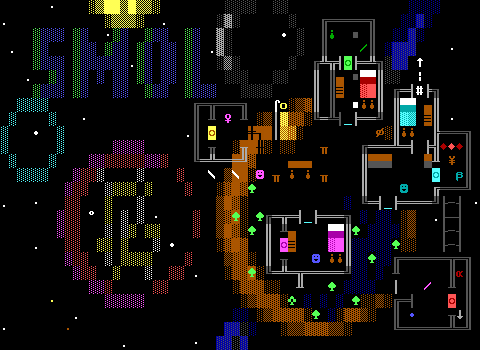
Oh! I got to win the poll choice for July! Me!
When patrons nominate stuff, they get the luxury of getting to pick something they hope wins every time. I can't say the same for my own pick, which was a placeholder of "You pick for me, and I'll get back to you with something new when that wins." I already get to enjoy free reign of what ZZT games to cover, putting me in the situation of having to choose a game that I'm interested in writing about, but not so interested that I'll be annoyed if it takes awhile to win. Of course, it also has to not bug me if it doesn't win either. Once it's on the poll it would feel like I was going against the spirit of things to take it off the poll and just write about it and replacing it with something else.
So, another Nivek title fits these unrealistic goals surprisingly well. I've streamed Blood Oath: Trials of the Wyrm. I've written about Defender of Castle Sin and the Space Fighter: Mercenary series. Nivek has earned a solid I, don't know, B+? reputation from me. His games are most often fantasy RPGs that take things seriously and stick to the kind of lore you'd expect out of an officially licensed Monster Manual. The ideas contained within tend to deal with great sealed evils and what might happen if they were to break loose. They can be expected to have some good artwork with lovingly crafted blank-faced designs built with walls more than highly detailed arrangements of objects. His games are generally enjoyable, not too long, have their flaws, but their charms as well.
The design contrasts nicely with the fantasy RPGs published by Interactive Fantasies around the same time which tend to be more light-hearted, silly, and fairy tale-like in nature. Nivek strives to be more Tolkien* or traditional Dungeons and Dragons. You won't find characters named "Jackson Tough" or "Mo' Fat" in Nivek's world, but you will find enormous hellspawn capable of tearing a wizard in half, and that tends to be more of a surprise during gameplay!
(* I have never read any Tolkien.)
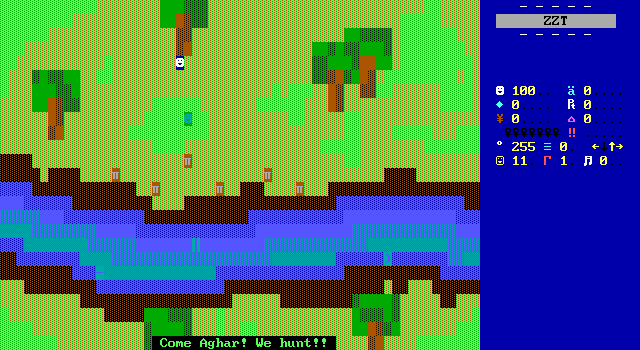
Smash or be Smashed sounded like it was going to fit the mold used before, but it breaks away from a lot of Nivek's staples making for a very different kind of adventure than his previous works. This makes some sense, as after a lengthy career making ZZT worlds started back in 1996, Smash or be Smashed is Nivek's final release. In some ways things are more elaborate than the previous covered released. The game breaks away from the strict linear designs from before, creating an open-ended world to explore with hidden caves, multiple villages, and secret items to collect. At least, that's the claim.
It sounds fun, but there's a pretty big catch: There's no way this game is actually finished.
Coming in at just over fifty boards, there's plenty there going by the numbers. Castle Sin and Blood Oath are both roughly the same size and felt like fully fleshed out games. Fifty boards is plenty, Town of ZZT is an open-ended adventure of good size that fits in little more than thirty boards after all. The thing is, Town has things to do on the vast majority of boards. Smash or be Smashed unfortunately suffers from "big empty world syndrome", where there are a lot of paths that can be taken to reach landmarks, but the journey to those landmarks is just taking in the scenery and nothing more. I don't think any amount of skillful graphics can make a world this empty enjoyable to explore, and Nivek's graphical talents lie mostly in creating static art boards, not varied scenery.
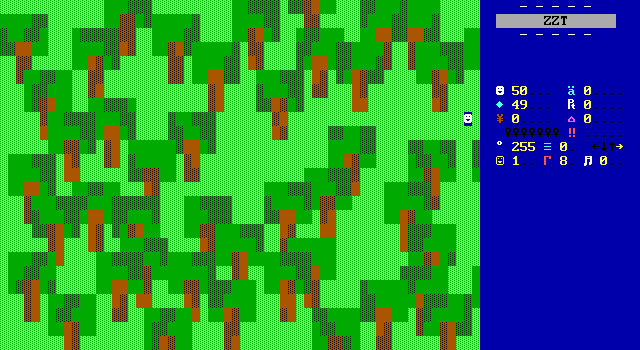
This is what boards in this game look like. Here we have a more dense forested area, but the plains are this with fewer trees. It's perfectly serviceable. This is definitely a forest. There's just nothing really there other than these trees.
Still, I do have to respect that a lot of effort had to go into creating this kind of board. Smash or be Smashed predates any external editors, meaning no copy/paste functionality exists. Every single tree in the game had to be drawn out by hand. Today this kind of board could be thrown together far more rapidly, but here it's an artisanal work.

There's also a question of authorship here. The title screen credits the game to "Choco", a name not credited anywhere else on the Museum. The game contains no documentation, so the only instance of the name Nivek is in the author field as imported from z2's own archives. While who did what was somewhat ambiguous with Space Fighter: Mercenary, another game credited to two names, here I am genuinely unsure if Choco is a second person or not. I'm leaning towards Choco being an alias of Nivek, but can't speak with confidence as to how this game came about.
This game is the last to have Nivek listed as an author, and nothing else lists Choco, so I can definitely see this as a rebranding. ("My first name but backwards" definitely feels like an old style Internet alias.) That this game's release feels more like a project dump brings along implications of retiring from ZZT and moving on in life, whether intentionally or not.
If the reality is that someone named Choco made this and Nivek quietly contributed some art, I'd believe that as well. There's really nothing concrete here, and while there's enough similarities to Nivek's games and general style that I can see it being a one man venture, I want to apologize in advance if Nivek had little or nothing to do with this game as it's got enough flaws that I'd rather not tarnish perceptions of his work with ZZT.
So I'm opting to just use Nivek here due to the similarities and the fact that the name is credited. Keep in mind that he might not actually be the person responsible for the game's design.

Nivek's games tend to focus strongly on magic so playing as a barbarian with a big axe whose only interest is in smashing things is definitely unusual, even if the setting still aligns with previous releases. The game's writing really leans into this primitive caveman-speak even to its own detriment. It's fine for single sentences here and there. It fine when it's just a few hostile words as an insult to a dishonorable foe or bellows of excitement at discovering a more powerful weapon.
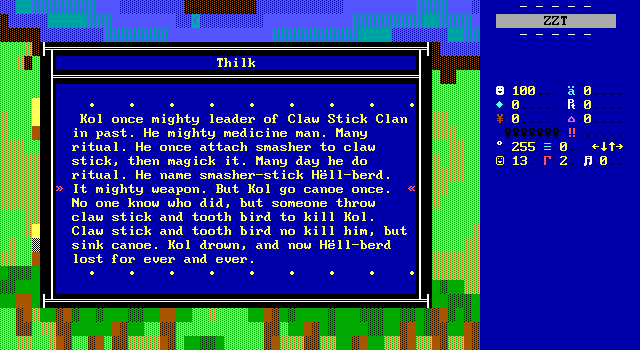
Once you reach a proper paragraph, it gets a lot less enjoyable. This can get a little more annoying as it's very difficult to remember which clan is which when this is what you're given to read. Claw Stick, Big Axe, Bear Smasher, Tooth Bird are all effectively interchangeable in dialog as the only real way any of them differ is that the Tooth Bird tribe is full of jerks.

Another issue the game suffers from is that it's very unclear where you should be going or what you should be doing. The opening text sets the scene a little with an unknown force killing non-barbarians and even (gasp) weaker barbarians. Things are getting dangerous and the chief of your tribe (Big Axe of course) wants to discuss things with you.
So when you start off in your little village, and all the huts have empty spaces for doors, that makes me think that I should be going to the campfire where several people are sitting.
No such luck actually. While you can indeed talk to everybody, the only thing of interest is a sidequest to go out on a hunt with a fellow member of the tribe to get some food for the village to share.
I wandered across several villages unable to advance the game's main plot because you actually do need to talk to the chief in his hut by touching the blank spot. The other huts are indeed made of empties so there's no feedback for any of them, making it surprisingly easy to miss. Admittedly, a shipwright standing outside the hut will tell you that this is the chief's, but empty spaces do not effectively communicate that there's something there to interact with. A passage character, a door character, or perhaps just closing off the doors of the buildings that can't be interacted with would go a long way in making things clearer.
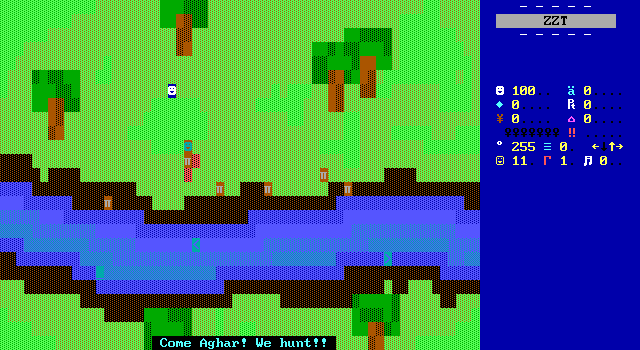
The game is mostly structured around doing small quests for your tribe and the other friendly tribes in the area. The rewards don't make these worth it, but there's not a whole lot to actually do in Smash or be Smashed otherwise, so it's worth taking them just to get some variety. A few will lead to getting "shiny rocks", the game's currency, though there's really only one thing to buy until the very end of the game.
I do get the feeling that Nivek is genuinely trying to create a different experience here. This first quest is likely going to be most player's introduction to combat which is entirely melee based, and one of the better parts of the game that will be worth going into in more detail when doing some fighting for the main quest.
Here, the wolves don't put up much of a fight, almost entirely running away once Aghar and his hunting partner Khal arrive on the scene. A few swings of the axe via touching are all it takes.
Where the game does stand out though, is that these kind of quests can be failed without a game over, or a dead-man walking situation. If Aghar heads to the hunting grounds alone, the wolves will all run off without Khal to help corral any, leading to Aghar being chastised if the quest is accepted later and there are no wolves to be found.
Similarly, you can just tell Khal that you're busy and can't go hunting. He'll go off by himself, reassuring the player that it's fine, and preventing the quest from being taken later. The prompt to accept/deny the invitation will repeat until a choice is made, so there's no returning to it later, even though accepting it comes without consequence and allows the player to actually go hunting whenever they like.
In this way, the world being built in Smash or be Smashed is trying to be a more realistic one. Aghar's whims are not the sole decider of what does or does not happen and the village has to get food sooner rather than later. ZZT being ZZT, it's difficult to really track the state of everything, so doing quests as soon as you can is the safer option than running the risk of running out of a very limited number of flags.
ZZT or not though, this is not some AAA game trying to sell you on unprecedented realism or whatever. Cutting the player off from these events sets the player back with no reason to do so. Were there a second NPC offering a quest that was mutually exclusive then we'd have some depth. Instead it's just an unnecessary punishment for not blindly accepting a task.
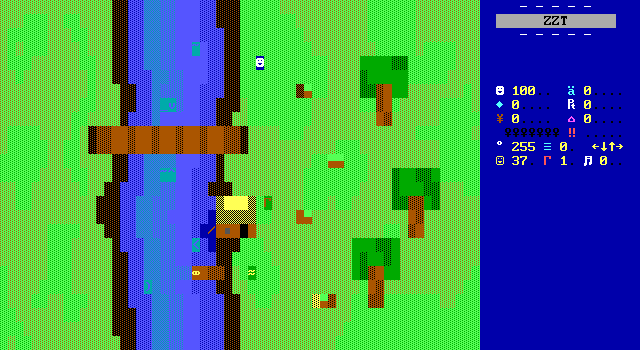
The world here is really just divided into plains, forest, and a single board mountain. The only other geographic feature is this river that cuts across quite a number of boards. Again, Nivek is doing things a little differently. The river has the illusion of movement created by placing some transporters in its path. It's partially meant to create some sense that the water is flowing, and partially just being sneaky about the fact that eventually the player will be able to travel along the river and some of those transporters exist to get past bridges that go over it.
The home here belongs to the shipwright where there is a canoe that Aghar refuses to take without permission. It makes it pretty obvious that at some point the player will get onto the river, but I like the light deception. Until the player's exploration lead them west, it's genuinely hard to say for sure if the river is actually traversable in some way.
Speaking strictly as a form of indicating motion however, and I think the effect falls flat. Later games like Rogue Three (go ahead and hit "Play This Board" on that one) would come up with some more impressive looking flowing water. What's on display here can't confidently be read as "Oh that's so the player can navigate the water", but it will immediately make you consider the possibility, making you draw your eyes to the purely decorative transporter currents and focusing too much on how they can be used as transporters rather than how they can be a representation of flowing water.

The first of several signs that this game isn't quite done comes from these fruit-bearing trees. I was quite surprised to learn that they're entirely decorative without even so much as a description when touching them. There's not even a quest to get some apples that lets Aghar grab them later on. They are completely codeless.
As decoration goes, that's okay. They liven up the environment a little adding a bit of needed color to a game that leans so heavily into green and brown. It's just another odd case where if the trees with fruit aren't important, I'd much prefer that the overall visual appearance was livened up with them throughout the game rather than just these three random trees.
It seems though, that for ever criticism I have of boards in Smash or be Smashed, there's always a silver-lining. SolidHUD spoils all board exits for me, but I think this board does a fantastic job at "hiding" the exits to the north and south. Perhaps the true purpose of the fruit is to draw the player's eyes away from the narrower exits, focusing all attention onto the center of the board instead. In that regard, I'm quite impressed by the technique.
Or, I would be were it not for the fact that on the previous board Aghar comments on the nearby villages and how to get there. (Well, kind of, he mistakenly says they're to the east rather than the west.) This is also the sort of thing that I'd be annoyed with if I wound up running around in circles not noticing or being able to reach the two bordering villages. The northern village can be reached from other sides, but the untrustworthy Tooth Bird tribe's village can only be reached from this board.

The theme of these other friendly villages is world building, but not much. There's no tension between the tribes other than the agreement that Tooth Bird sucks because they are hostile to outsiders. Combine the tribal friendliness, the lack of shopping (or what would be more impressive would be bartering) for ammo, torches, or health along with the fact that every tribe's village is so close to one another, and what you end up with is that they feel very superfluous. You could just as easily shove every single NPC from Bear Smasher and Claw Stick onto the starting board and have the game work just as well.
I was really surprised to see all these villages were so close to each other, both geographically and platonically. It waters them down into "good" and "evil" with nothing other than the names to differentiate them. These feel less like different cultures trying to survive and more like less colorful team names for Legends of the Hidden Temple.
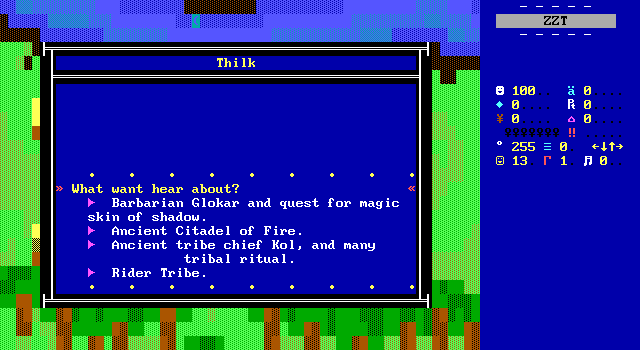
Which may be a fitting comparison as the only NPC of interest in Claw Stick is Thilk the sage who has a variety of legends to share at the bonfire. This is one of the most clever ideas in Smash or be Smashed. While these stories don't add a whole lot to the history of this world, they are trying to. But it's not the history lessons that make these stories worth hearing, it's the fact that every single one of them is actually providing the player with bits of information about other quests and secrets to discover.
Glokar mighty barbarian from Claw Stick
Clan. Long long time ago he quest to get
skin of shadow-beast. Legend say warrior
with shadow-skin no be seen by enemy or
prey. Glokar find scroll. It say that
home of shadow beast in the cavern where
eternal wind blow. In heart of living
mountain. Glokar leave for quest one day,
but never come back. No one know where he
go. But he was honorable warrior. Many
like Glokar.
If you find bones of Glokar we give many
shiny rock that we find. You want try?
• • • • • • • • •
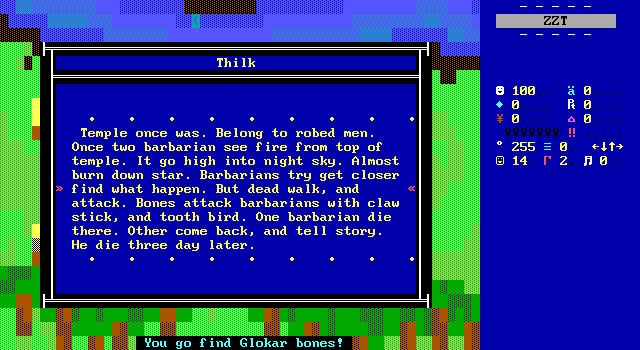
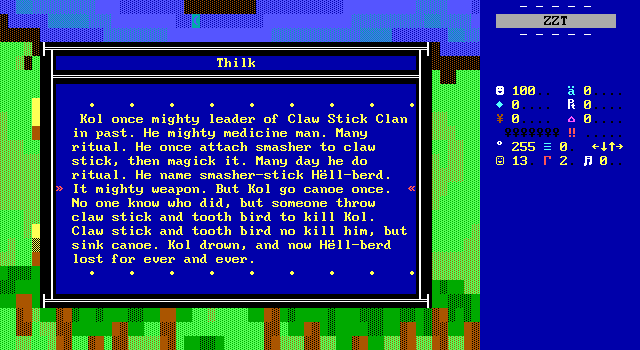
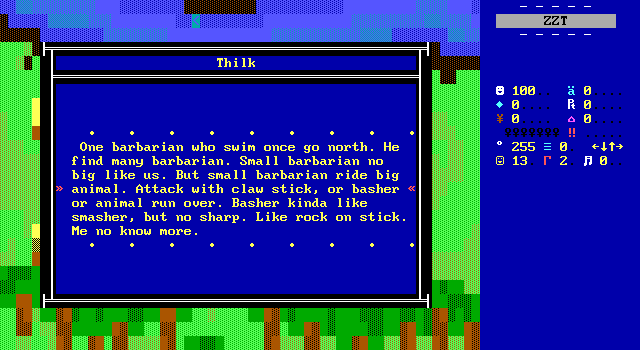
You won't know it upon first reading them, but every legend being based on fact is a very cool touch that trusts the player to make the connection themselves later. That's a bit of a tall order when you're having them all dumped on you this early on, but for those that pay close attention (ie: not me) this is a very cool idea that would be great to see explored further in new ZZT worlds today.
The player is now armed with the knowledge of the lost expedition of Glokar, the rituals of a mysterious people held in a temple, the loss of a powerful weapon, and the strange peoples of the north. How much any of them actually matter in order to get through Smash or be Smashed is a story best left untold.
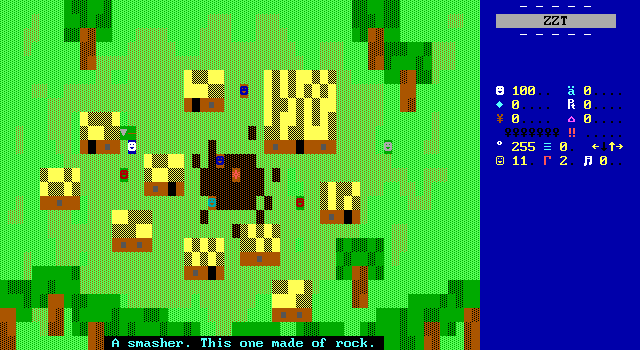
Village number three is just west of the apple trees, and belongs to the Bear Smashers who have a bit of a predicament.
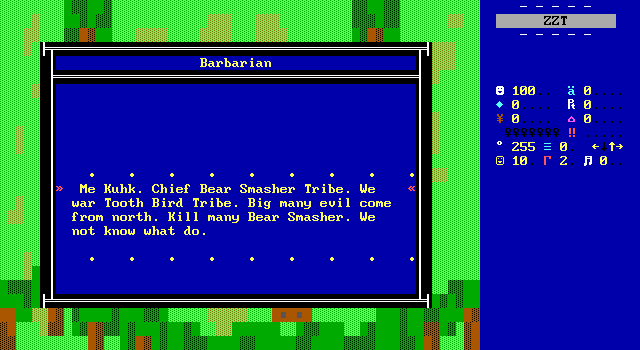
According to the chief, the clan is currently at war with the Tooth Bird clan while also being under attack from unknown assailants from the north.
That's all there is in this village really.
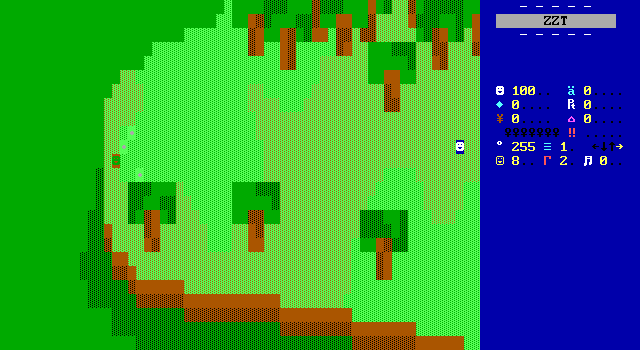
This leads to land's end where a cliff prevents traveling anywhere else. It's no ordinary cliff though. The Bear Smasher sage Hoki has discovered that if you drop a stone off the cliff, instead of falling straight down, it gets pushed away from the cliff as if the cliff were alive and breathing.
Weird, but there's not much to do here other than grab a rock for ourselves.
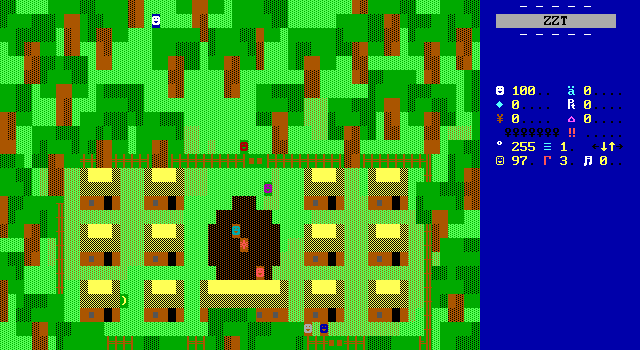
There's still one last village to check out, the home of the mysterious Tooth Bird clan. While it's still extremely close to all its other neighbors, the density of the trees makes it come off as more of a secret location.
The town immediately stands out compared to the others. First it has a protective fence surrounding it, keeping outsiders like Aghar away. It is also considerably more structured than the other villages. The homes are neatly arranged in rows. It could be part of the limited space to fit the buildings and have the town be navigable with this many trees around, or perhaps there's something different about Tooth Bird...
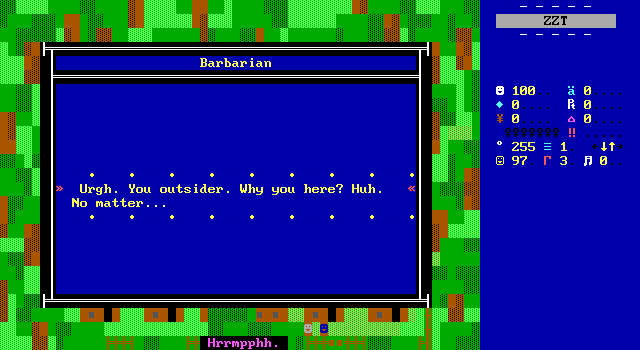
Despite the heightened security, Aghar is let in by just saying that he wants to talk with their leader. He's warned to not try any funny business, and then given free reign of the place. Unlike the other clans, the Tooth Birds clearly don't trust him.
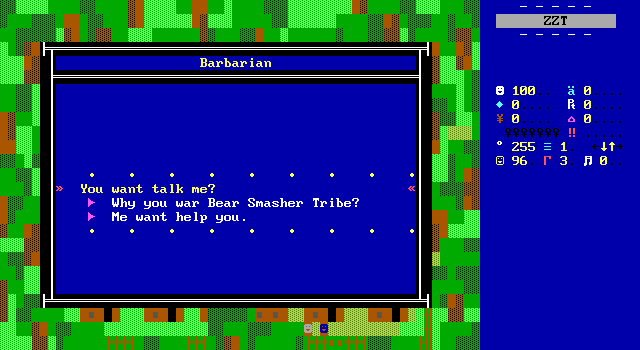
Speaking with the chief offers up a rare instance of a morality choice. The player is given the option to try and understand the cause or the war, or to just suddenly choose an unlikely side.
The former is met with instant dismissal from the village. At this point the chief won't say anything else.
If instead you decide to help them, you're told that because you're not a Tooth Bird the Bear Smasher clan won't see an attack from you coming, and told to kill their chief in exchange for some shiny rocks.
Were Smash or Be Smashed a game with an actual morality system where your actions determine what quests are available to you, I'd probably have more to praise it for. Even a barebones Good/Evil with no in between state would at least give the player a reason to try the game a second time. Instead, this is really the only time the player can choose to be evil.
This dark path is pretty short lived. Aghar walks up to the chief and kills him without any actual fight, though the killing causes the rest of the villagers to start chasing the player down. For completing the quest the player gets a few gems and that's all there is to it. The other tribes don't react to this at all, and the only impact this has is with relations to Tooth Bird that still don't change how events play out, just the specifics of dialog.
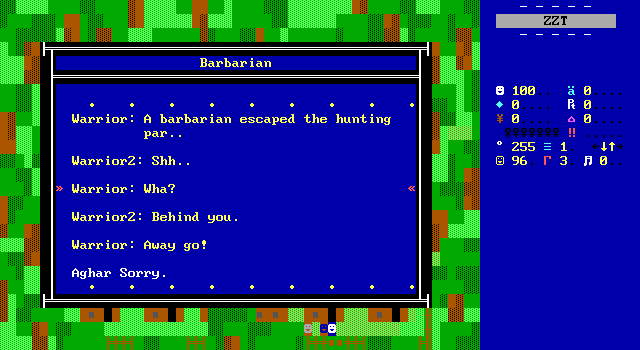
This though, is one of the high points. Aghar can eavesdrop on two warriors in the back of the village where the player will find one speaking a far more developed English. It's not much, but when taken with the other oddities of Tooth Bird, it definitely feels like there's something mysterious here.
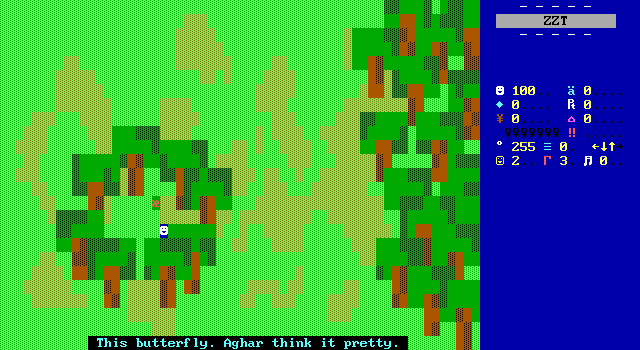
With the west half of the map explored and very little to show, I turned around to see if there'd be something to actually do out to the east.
And there isn't really, but there is a touching moment where Aghar admires the beauty of a butterfly.
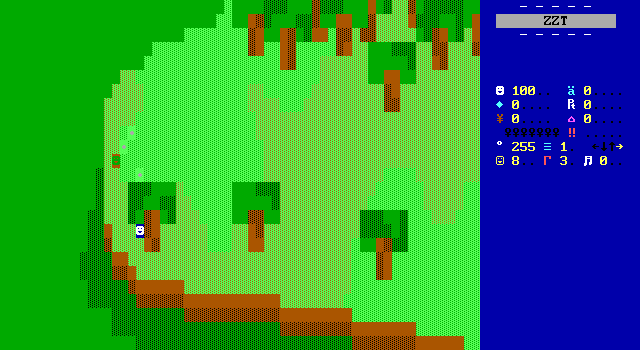

Having missed my cue for the main quest, I was completely stuck and forced to look into the game's code to figure out what I could actually do. Looking for where some of my set flags would be checked I was able to uncover this tree that looks identical to any other that has precisely one tile that can be touched to tie a rope to it in order to descend the cliff and reach a hidden cave.

This is where the game bugs out for the first time. The object that draws the rope graphics has to tunnel through some walls to clear a path before it is able to move. For one step this is accidentally overlooked and so the object keeps trying to move into a wall forever.
This quest is ultimately optional, and thank goodness given the odds of finding it organically without getting really desperate to find something.
Obviously cheating your way to the passage is one option, but another is to just walk right into it. The miscount may be related to changed geography over the game's development or something, but as it turns out one of the brown solid walls is actually the passage to the cave. The intent is for it to be revealed by the rope object although it never needs to do anything since the passage is actually accessible from the grass at all times.
So if you are desperately pixel hunting you might just find the passage before you find out you can tie the rope anyway.
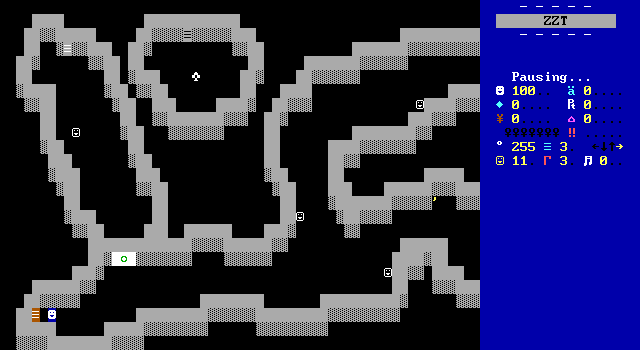
Now it's a Nivek game.
For all the perfectly average graphics so far, and for all the skill Nivek shows with his character art, for whatever reason, he always makes his caves black floors with a black background. It's the house style, but not in a good way. At least you can say that even at his worst, the graphics reach the minimum, but surely by the time of his final ZZT release he could attempt something here? I still think that just filling the background with something other than empties would help considerably.

The cave doesn't lead to any text whatsoever. Aghar makes no comment on the cave system or the fact that he's now fighting skeletons in what has up to this point been a game grounded in reality. Given the fantasy tropes seen in most of Nivek's other works, their presence isn't exactly a shock to the player, but perhaps Aghar could speak up and let us know if animated skeletons are just a regular problem or a total shock that completely changes how the barbarians understand the world.
They are instead just some basic foes to smash or be smashed by. In fact, they're identical to the code for the Bear Smasher clan warriors once their chief is killed. They move towards the player, then randomly, though the skeletons deal more damage. The slow speed of the skeletons, running at the default cycle three, means that Aghar really has to try to be hit as they only check to attack once in their combat loops and have idles dividing their movement commands.
You might interpret this to mean that Aghar is a badass hulking barbarian with a giant axe and everyone, skeleton or not, should be afraid of his wrath. That's a generous interpretation here though as the lack of any text means the only thing the player will read into the situation is what they imagine. These skeletons are just as likely to be pushovers.
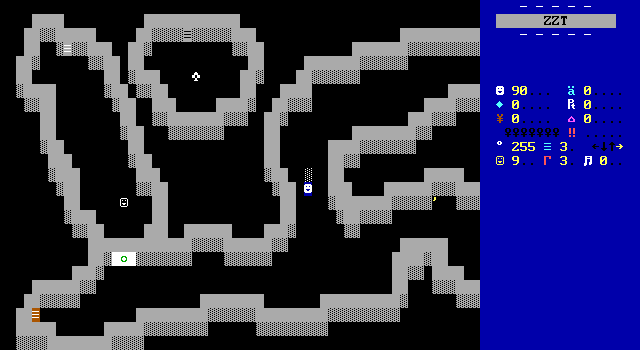
The only thing that feels like it has effort is that rather than be mashed into a fine red paste (#BECOME RED FAKE), the skeletons are instead ground to dust before they fade away entirely. It's a cute touch, but the combat here feels so... barebones that it simply doesn't come close to the much more.... fleshed out combat seen in previous Nivek releases. Granted those weren't exactly high quality gameplay either, but they were built up with the world around them, lending them clout whereas these guys are just "My first dungeon crawl" combatants.
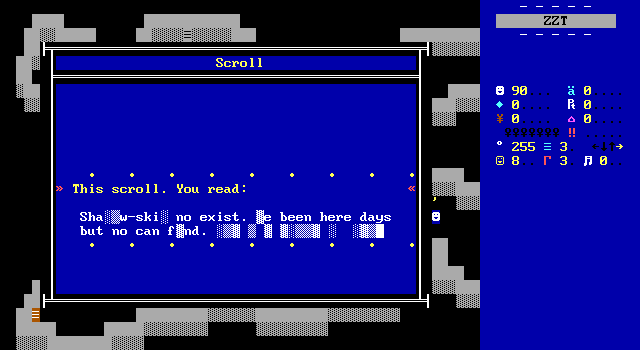
Some actual worldbuilding at least does show up in the form of the classic long-faded scroll on the ground. This must have been written by Glokar who went off in search of the shadow-skin but never returned!

The cave design isn't particularly exciting either. This is the kind of quality you expect from a 24 Hours of ZZT game, not a seasoned ZZTer's final release. You either take the path to a dead end, or take the path that holds the purple key, and the lights are on so you can immediately tell which is which. Defeating enemies doesn't give shiny rocks, health, or even points making it a waste of time to step in the top half of the room at all.

Now it's a Nivek game!
Before Aghar can reach the green key the player will step onto an invisible passage and smash or be smashed into a pit! Unlike Defender of Castle Sin where this was just used as a mean trick where a bad step would land on an invisible passage and lead to a game over, here the fall is intended and takes no health from the player.
But the callback isn't important, it's the art. This is what I mean when I praise Nivek's graphical capabilities and why the blank looking caves are always such a letdown to see. This is a hell of a pose for a ZZT game, and even more-so for one of this vintage. It sent me scouring through previous Closer Looks and livestreams trying to come up with anything that conveyed motion through static art this well. Nothing comes close. The action lines certainly contribute quite a bit, but even without them this is clearly a dude in peril. Even the axe looks great at the angle its drawn.
While graphics can certainly impress, they alone do not a good game make. Despite this board definitely being the most appealing board in Smash or be Smashed it's a long way out of this pit the game has already been in. Instead it gets to serve as a reminder for what Nivek's best efforts look like.
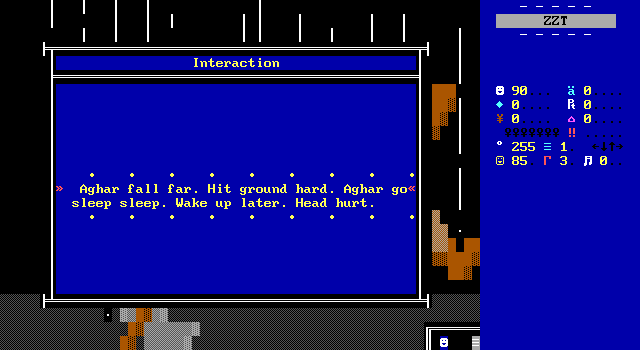
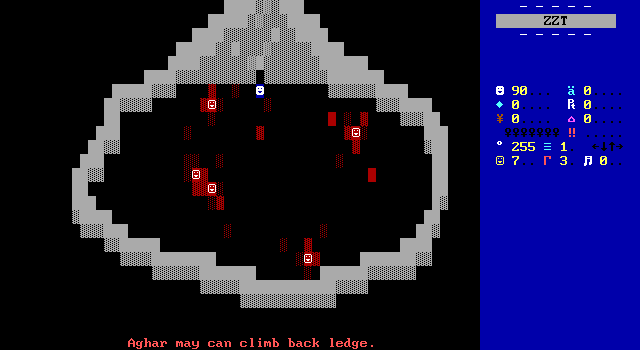
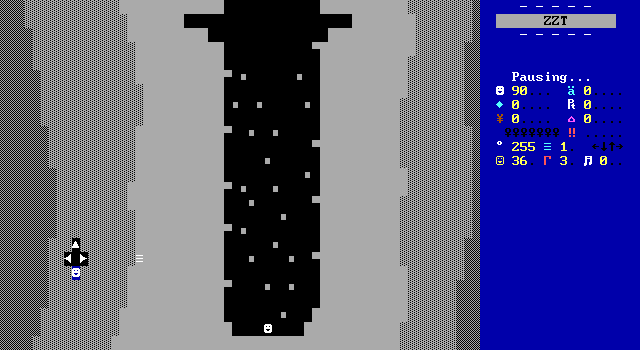
All of it is just to introduce a simple platforming engine.
There's very little to see here. It controls decently enough. The player can't die, and while some of the platforms will fall when stepped on it's pretty fair. It beats more skeletons at least. The only real flaw of it is that the engine isn't robust enough prevent a player that moves off of solid ground from jumping once while in the air.
Also, it has a background and I think the board looks better for it.
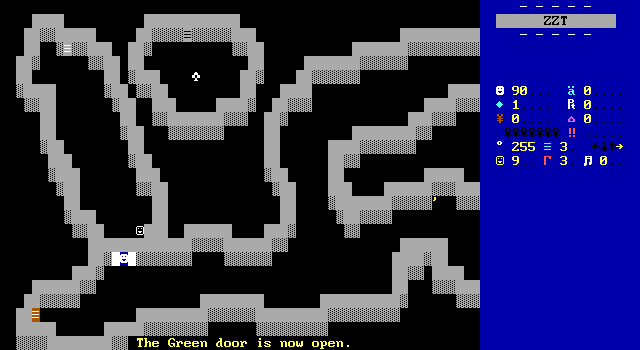
Aghar escapes the pit, grabs his key, and unlocks the door at the start of the cavern where one skeleton is ready to be ignored as he rushes to the next passage.
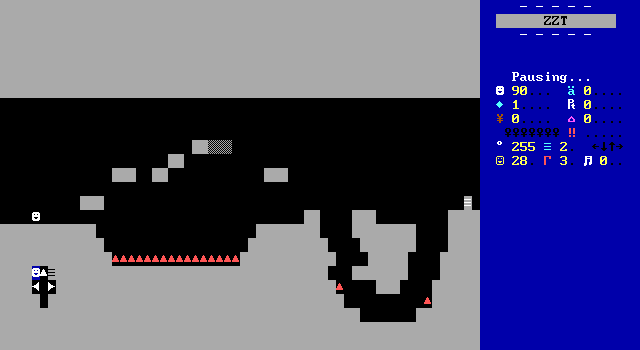
Only to soft-lock the game as the player spawns on a passage of matching color rather than the default player position for the board. This bug is a bit rougher than the rope as there's no way to get around it in vanilla ZZT v3.2. Using a modern port a cheat to change the current board allows arriving here on the default position and letting the player enjoy some more (albeit uglier) platforming.
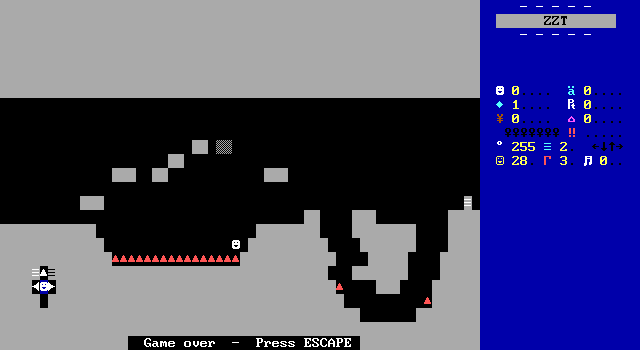
This time you very much can die thanks to some sharp spikes along the ground. The engine design lets the player move freely though so there's nothing stopping you from saving before any tricky jumps. To no surprise, the platforms that look breakable will break when stepped on.
The pit climb worked a little nicer. This is just pressing your luck at how invested the player is going to be to actually play this when they had to go back and edit the game to make it playable.
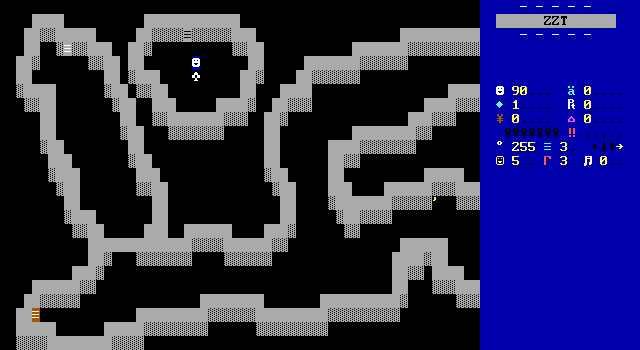
All of this is to recover Glokar's bones, which aren't identified as such, though the ability to access the cave (well, via rope) requires that Aghar agrees to find the bones so it's a pretty safe bet.
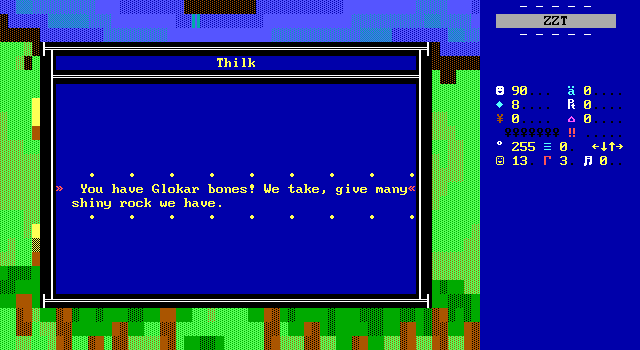
Afterwards it's a brisk walk to the exit of the cave where Glokar died because he was unable to find the exit. (That's not fair to Glokar, he didn't have a rope tied to a tree to climb up.) The reward is another seven shiny rocks.
Unfortunately, this meant no real progress. Back at square one I had to again search for what I was actually supposed to do, and finally realized my mistake in not actually ever talking to Big Axe chief like I was told from the very beginning.
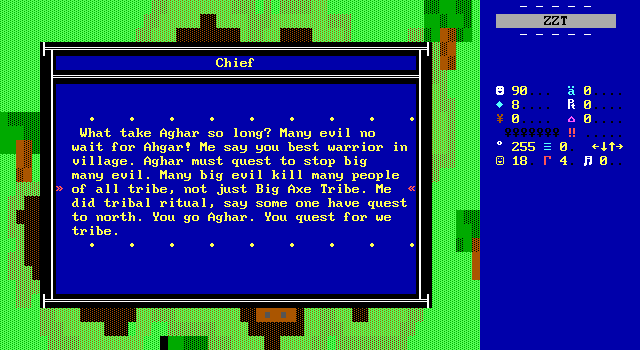
Very amused by the complaint that I took so long to get here. If only you knew chief.
So yeah, a little late, but here's the game's actual story. All the tribes have been attacked by strangers from the northern mountains and Aghar was chosen after a ritual gave the chief the insight to send his strongest warrior to the north. The ritualistic interpretation is a nice way to gloss over the obvious question of why send Aghar alone.
Now normally this would mean the player is free to immediately go north right from the start of the game without checking out any of the other villages or looking at butterflies. Having the script flipped a little like this doesn't have much of an impact on the story really, it's just something to keep in mind when considering the game's length once you realize how little there actually is that needs to be done.
About the only real difference is that by exploring the villages first, Aghar has heard the legends and knows that the people of the north are mysterious and a force to be reckoned with, though there aren't really any specifics that will make the journey easier by having heard them.
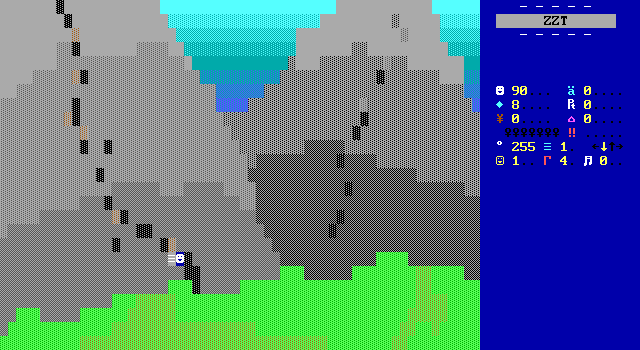
These mountains are pretty legit and make for a nice transition between the mostly friendly plains belonging to the barbarian tribes and these other folks up north.
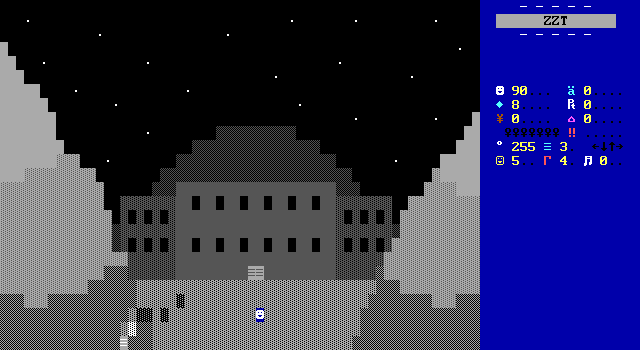
The climb is instantaneous for the player. For Aghar, it's clearly a long trek and used as an opportunity to advance the clock to after dark.
On its own the temple isn't particularly impressive, but just as the stories said, some sort of fire is being shot up into the sky, lighting the entire building rather impressively. There's a good sense of scale with how tiny Aghar is in the scene which definitely makes for an imposing and potentially scary atmosphere which definitely makes this one of the nicer looking boards of Smash or be Smashed.

